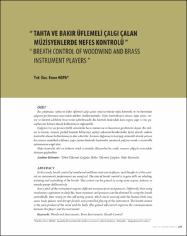| dc.date.accessioned | 2020-06-15T06:58:43Z | |
| dc.date.available | 2020-06-15T06:58:43Z | |
| dc.date.issued | 2013 | en_US |
| dc.identifier.citation | Hopa, E. (2013). Tahta ve bakır üflemeli çalgı çalan müzisyenlerde nefes kontrolü, 4 (4), 109-116 | en_US |
| dc.identifier.issn | 2146-7692 | |
| dc.identifier.uri | https://hdl.handle.net/11421/23276 | |
| dc.description.abstract | Bu çalışmada, tahta ve bakır üflemeli çalgı çalan müzisyenlerde nefes kontrolü ve bu kontrolün
çalgının performansı üzerindeki etkileri incelenmektedir. Nefes kontrolünün amacı, nefes alma, verme ve kontrol edebilme becerisinin edinilmesidir. Bu kontrol, bedendeki bazı organ, yapı ve kas guruplarının bilinçli olarak kullanımıyla sağlanabilir.
Çalgının her ses perdesi farklı oranlarda hava miktarına ve basıncına gereksinim duyar. Bu miktar ve basınç, insanın günlük hayatta bilinçsizce yaptığı solunum hareketinden farklı olarak, nefesin
kontrollü olarak kullanılmasıyla elde edilebilir. İnsanın doğumuyla başlayıp otomatik olarak çalışan
bu sisteme müdahale edilmesi, çoğu zaman bedende kasılmalar yaratarak çalgının esnek ve kontrollü
çalınmasına engel olur.
Nefes kontrolü, akıl ve bedenin ortak ürünüdür. Kazanılan bu irade, insanın çalgıyla arasındaki
iletişimi güçlendirir | en_US |
| dc.description.abstract | In this study, breath control of woodwind and brass instrument players and the effects of this control on instrument’s performance are analyzed. The aim of breath control is to gain skills on inhaling,
exhaling and controlling of the breath. This control can be gained by using some organs, features or
muscle groups deliberatively.
Every pitch of the instrument requires different measure of air and pressure. Differently than using
involuntary aspiration in daily life, these measures and pressures can be obtained by using the breath
controlledly. Intervening on this self-acting system, which starts working with the human birth may
cause body spasms and disrupt flexible and controlled playing of the instrument. The breath control
is the joint product of the mind and the body. This gained self-control improves the communication
between the player and the instrument. | en_US |
| dc.language.iso | tur | en_US |
| dc.publisher | Anadolu Üniversitesi | en_US |
| dc.rights | info:eu-repo/semantics/openAccess | en_US |
| dc.subject | Tahta Üflemeli Çalgılar | en_US |
| dc.subject | Bakır Üflemeli Çalgılar | en_US |
| dc.subject | Nefes Kontrolü | en_US |
| dc.subject | Woodwind Instruments | en_US |
| dc.subject | Brass Instruments | en_US |
| dc.subject | Breath Control | en_US |
| dc.title | Tahta ve bakır üflemeli çalgı çalan müzisyenlerde nefes kontrolü | en_US |
| dc.title.alternative | Breath control of woodwind and brass instrument players | en_US |
| dc.type | article | en_US |
| dc.relation.journal | Sanat ve Tasarım Dergisi | en_US |
| dc.contributor.department | Anadolu Üniversitesi, Devlet Konservatuvarı, Müzik Bölümü | en_US |
| dc.identifier.volume | 4 | en_US |
| dc.identifier.issue | 4 | en_US |
| dc.identifier.startpage | 109 | en_US |
| dc.identifier.endpage | 116 | en_US |
| dc.relation.publicationcategory | Makale - Ulusal Hakemli Dergi - Kurum Öğretim Elemanı | en_US |
| dc.contributor.institutionauthor | Hopa, Emre | |


















